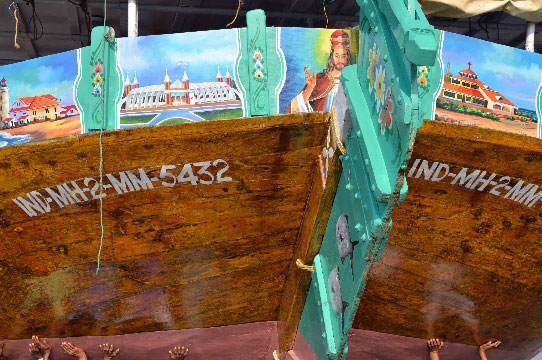The ship stood about 200 feet from the low tide line and what I was to witness was a fascinating spectacle, one that used raw human power and relied on the basic principles of physics. Using nothing more than sea-seasoned logs, pulleys, rope, sailor’s knots and raw human effort, the ship was moved with unconcerned coordination in a matter of two hours. There was no evidence of any modern technology being used, and all the participants, numbering a hundred in all, moved in perfect rhythm to the chant of a mukkadam’s song.

Bamboo frames are used to dry fish and prawns.

The boat, a 70-footer, is propped up on two sturdy tree trunks. These are the rails on which it will be slid into the sea.

A sailor's knot.
A strong religious angle was evident to the ceremony. The service in Marathi was administered by a genial priest, who sprinkled holy water and broke a coconut on the motor casing, lending to the duality of the proceedings. The pilot’s cabin is watched over by a soapstone Mother Mary while the rear panels feature scenes from the Bible and perspective views of the local attraction: the shrine dedicated to Our Lady of Vailankanni.

Hands joined in prayer during service.

The priest blessing the ship.

The hand-painted helm of the ship.
Two teams of sturdy fishermen dressed in their traditional kashtis were stationed on either side to stabilise the craft, while people in front slithered the keel on the water-slickened logs. In quick succession, the boat would be raised by wedging the side poles below the main rail, wedges inserted to stabilise it, and the team in front would haul it forward for about 20 feet with a blood curdling roar.

Fishermen line up to pull the ship to the water's edge.

The joint effort of two teams pulling the ship to the water's edge.

Fishermen slide the ship with nothing but brute human force.
By ten in the morning, the boat stood at the water’s edge awaiting the high tide, which would float it out to sea. I was invited to a repast of chai and khari biscuits and surreptitious sips of ‘santra’ – the local fire water. In a world increasingly caught up in the race to newer technology, I was witness that morning to a time-arrested world.
See more of Manjunath Shenoy's photographs on his Facebook page.










